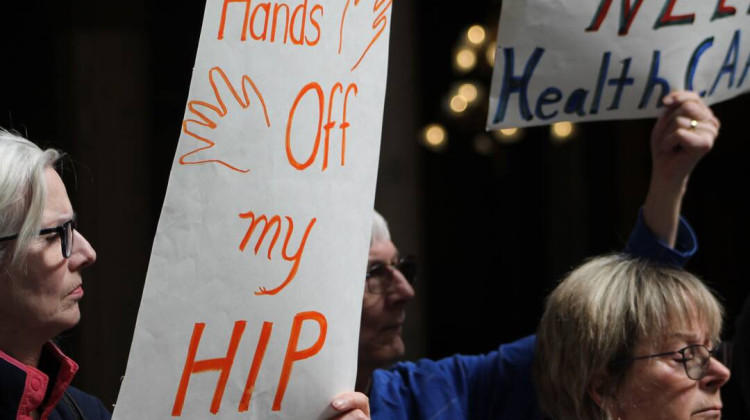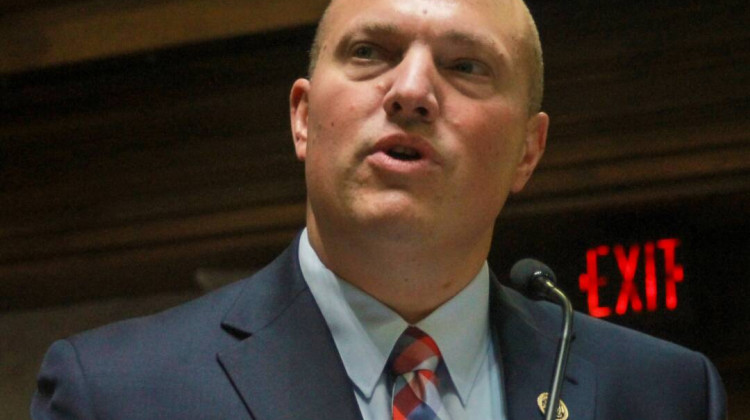
Vivitrol, a relapse prevention drug, is given to some defendants at Ohio's Franklin County Municipal Court as part of a new clinic.
Paige Pfleger/Side Effects Public Media
The Columbus, Ohio, area has been hit hard by the opioid epidemic. And local judges say their courtrooms are jammed with misdemeanor cases that are tied to addiction. Eager for solutions, they're turning to a treatment clinic in an unlikely location.
On a busy morning at the Franklin County courthouse, Jessica Gurwin joins the crowd of people streaming through metal detectors and elbowing their way into elevators.
“You have to be aggressive, you’ve got to cut in front of people a little bit,” she says with a laugh.
On the sixth floor, Gurwin steps into a courtroom, walks past the rows of chairs and the judges bench, and opens a door revealing a make-shift clinic. A table is lined with boxes of rubber gloves, needles, and the drug Vivitrol, which is taken after detox and blocks opioid receptors in the brain in hopes of preventing relapse.
“It looks like a closet. This was actually the judge's robing room,” she says. “And the judges were basically like, 'We don’t need a room to put robes on. Let’s utilize this space to help people.'”
Gurwin works for Positive Recovery Solutions, a company that brings Vivitrol, a brand of the drug naltrexone, to places hit hard by the opioid epidemic. In July, they turned this robing room into a medically assisted treatment clinic that operates for six hours every Wednesday.
Franklin County Municipal Court judges say most misdemeanor crime cases they see can be tied to the opioid epidemic. Those judges, the City Attorney, and probation officers all hope the clinic can help.
The program is part of a nationwide trend bringing treatment closer to the criminal justice system. More than 3,000 special drug courts offer treatment as an alternative to a cell, and some courthouses now welcome programs like group counseling sessions.
But having a clinic physically inside the courthouse is unusual.

The medically assisted treatment clinic is in a small room behind the courtroom. (Paige Pfleger/Side Effects Public Media)
One Stop Shop
Since July, about 75 people have received shots of Vivitrol as part of probation. So far, about 60 percent of them are meeting all the terms of their probation: They come back for follow-up injections, visit a behavioral health counselor and check in with their probation officer.
“They’re coming here and they can get their food stamps turned on, they have their probation check-ins. All of the many, many things that you’ve got to do getting sober,” Gurwin says. “We’re taking care of a bunch of them every single Wednesday here. It’s kind of a one-stop-shop kind of situation.”
She says it takes a lot of buy-in across the city to make a program like this function, and that buy-in starts a few floors up in the courtroom.
From the bench of her courtroom, Judge Eileen Paley speaks sternly with a defendant.
“I will tell you now, if you do have a drug and alcohol problem, you will be back, and then you will have more problems to deal with,” she says.
Paley says the majority of the cases in her courtroom – from solicitation to stealing – are tied to addiction.
“People aren’t stealing out of greed,” she says. “They’re stealing out of need. There’s a desperate need for their next fix. I’ve actually had people using heroin in the bathroom and then coming into my court. Now think about that.”
She worries if people don’t get treatment after leaving jail, they will likely end up there again. A clinic inside the building, she says, makes the connection to help more immediate.
“If they walk out that door without having the information that they need, a lot of them don’t have transportation, a lot of them don’t have the resources, and then the next day they don’t go to where they’re supposed to go and they use instead,” she says. “I think it’s critically important that it’s in the building. It has to be.”
Motivation For Treatment
A few doors down, Judge James O’Grady says – depending on prior arrests – he is more than willing to cut a deal with someone who agrees to participate in the clinic.
“If somebody expresses an interest in getting treatment, then I take the jail days off the table,” he says. “I’m certainly not going to send someone to jail at that point because I realize that just putting someone in jail is not going to help someone with an addiction problem.”
If the defendant does go to jail, participating in the courthouse clinic program can be part of their probation. That’s what O’Grady put on the table for a defendant named Corey. Dressed in a tan uniform and handcuffed to a pipe on the wall, he’s swiveling anxiously on a chair.
He’s been in jail since July, and was using heroin before that.
“I’m about to have a child,” he tells Katherine Richards, a social worker at the probation department. “She’s six months pregnant, she’s going to doctor’s appointments on her own, really that’s my main issue, how long does it take to get it?”
Richards smiles knowingly. She’s heard this question before.
“You mean, how soon can you get out of jail?” she replies to Corey, who nods.
Richards says she fields questions like Corey’s all the time when signing people up for the program.
“It’s always a concern when their primary motivation seems to be getting out of jail,” Richards says. “But for people who are in jail, that’s just normal. It’s really hard to gauge motivation for treatment until they actually get with us.”
She says, even though it seems like Corey just sees the Vivitrol program as a quicker way out of jail, at least it might get him thinking more critically about treatment.
“Sometimes I think that we’re planting seeds,” she says. “We’re educating people about the option of recovery and maybe they aren’t ready now, maybe they’ll get one shot and we’ll never see them again. But the hope is next time they end up in jail, they’ll be more ready.”

The staff of Positive Recovery Solutions wait for patients to come to the clinic each Wednesday. (Page Pfleger/Side Effects Public Media)
Another Chance
If Corey qualifies for the program through Medicaid, then he’ll be released in just a week. When he is, someone from the clinic will be waiting at the jail when he gets out to walk with him to the courthouse. He’ll meet his probation officer and get his first shot.
That’s one of the most convenient parts of the program, according to Nate, another clinic visitor. He doesn’t want his last name used because he doesn’t want potential employers to know he’s in recovery.
“It makes it easier cause I can come here and then see my [probation officer] all in the same day,” he says.
This is his third time at the courthouse clinic.
“I caught a couple charges because I was out there doing the wrong thing,” he says. “It’s just misdemeanor probation. I’m doing better now. I have this program to thank for that.”
Nate walks into the make-shift clinic and the nurse, Katie Gast, greets him like they’re old friends. They talk about "Game of Thrones" and group meetings.
“We are doing your right side today, you excited?” she asks with a laugh.
“No! It’s a shot in the ass, who would be excited about that?” Nate says.
She gives him the shot and he heads for the door; the whole process only takes about 10 minutes.
Outside, Nate’s mom is waiting for him. She says last year, when Nate overdosed, she thought she had lost him.
“When you’re the actual parent to one of these kids that’s killing theyself, or even the grown folks, if you’re still the parent of that person, it’s heart-breaking,” she says.
She’s grateful he got in trouble with the law: It gave him a second chance at life.
This story was produced by Side Effects Public Media, a news collaborative covering public health.
 DONATE
DONATE









 Support WFYI. We can't do it without you.
Support WFYI. We can't do it without you.